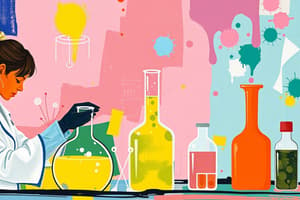Podcast
Questions and Answers
Always wear appropriate ______ protection (i.e., chemical splash goggles) in the laboratory.
Always wear appropriate ______ protection (i.e., chemical splash goggles) in the laboratory.
eye
Properly dispose of broken glassware and other sharp objects in designated ______.
Properly dispose of broken glassware and other sharp objects in designated ______.
containers
Never pour chemical waste into the sink drains or ______.
Never pour chemical waste into the sink drains or ______.
wastebaskets
Synthetic finger nails are made of extremely flammable ______.
Synthetic finger nails are made of extremely flammable ______.
Do not wear ______ lenses since they are potentially dangerous in a laboratory with an atmosphere of fumes.
Do not wear ______ lenses since they are potentially dangerous in a laboratory with an atmosphere of fumes.
Keep your hands away from your face, eyes, mouth, and body while using ______.
Keep your hands away from your face, eyes, mouth, and body while using ______.
Know the location of the emergency phone and know how to operate ______.
Know the location of the emergency phone and know how to operate ______.
In case of an emergency, follow the established ______ plan as explained by the teacher.
In case of an emergency, follow the established ______ plan as explained by the teacher.
Never run in the ______.
Never run in the ______.
Do not eat or drink in the ______.
Do not eat or drink in the ______.
Never work in the laboratory without the supervision of a ______.
Never work in the laboratory without the supervision of a ______.
Always use a ______ device when filling a pipette.
Always use a ______ device when filling a pipette.
Do not leave lit Bunsen ______ unattended.
Do not leave lit Bunsen ______ unattended.
Keep the floor clear of all ______.
Keep the floor clear of all ______.
Make sure no flammable ______ are in the surrounding area when lighting a flame.
Make sure no flammable ______ are in the surrounding area when lighting a flame.
Keep work area neat and free of any unnecessary ______.
Keep work area neat and free of any unnecessary ______.
Flashcards are hidden until you start studying
Study Notes
Laboratory Conduct Do's and Don'ts
- Avoid practical jokes or loud behavior to maintain a safe environment.
- Never run; walking is essential to prevent accidents.
- Eating and drinking strictly prohibited to avoid contamination.
- Personal audio or video equipment must not be used in the lab.
- Unauthorized experiments are forbidden to ensure safety.
- Avoid sitting on lab benches or tables to maintain cleanliness.
General Work Procedures
- Be knowledgeable about emergency procedures and exits at all times.
- Always work under the supervision of a teacher in the lab.
- Follow teacher's instructions precisely for all experiments.
- Report spills, accidents, or injuries to a teacher immediately.
- Never leave experiments unattended while in progress.
- Handle hot glassware with caution; it may look like cold glass.
- Do not point test tubes at yourself or others while experimenting.
- Use pipetting devices instead of mouth suction for safety.
- Keep flammable solvents away when using flames.
- Never leave lit Bunsen burners unattended; turn off when finished.
- Ensure all heating apparatus, gas valves, and water faucets are off when not in use.
- Do not remove equipment or chemicals from the laboratory.
- Store personal items in designated areas; do not clutter bench tops.
Housekeeping
- Maintain a neat workspace free of unnecessary objects.
- Clean your work area thoroughly after each session.
- Ensure sink drains are clear; avoid blocking with debris.
- Do not obstruct exits or emergency equipment.
- Inspect equipment for damage before use; damaged items should not be used.
- Dispose of chemical waste in labeled containers only; do not pour down sinks.
- Immediately dispose of broken glassware and sharp objects in designated containers.
Apparel in the Laboratory
- Wear appropriate eye protection, such as chemical splash goggles.
- Use disposable gloves when handling hazardous materials; remove them before leaving.
- A long-sleeved laboratory coat or chemical-resistant apron is essential.
- Choose footwear that covers the entire foot; avoid sandals and high heels.
- Long pants are preferred; avoid shorts or short skirts for safety.
- Secure long hair and loose clothing to prevent entanglement.
- Contact lenses are not safe in fume-heavy environments.
- Remove dangling jewelry for safety; avoid synthetic fingernails due to flammability.
Hygiene Practices
- Keep hands away from face and body while handling chemicals.
- No food or drink allowed in the laboratory to minimize contamination risk.
- Avoid using lab glassware for food or drinks.
- Do not apply cosmetics in the laboratory or storage area.
- Always wash hands after removing gloves and before exiting the lab.
- Remove all protective gear before leaving the laboratory.
Emergency Procedures
- Familiarize yourself with all exits in the laboratory and building.
- Know the location of emergency phones and equipment.
- Be trained in using fire extinguishers, alarm systems, and eye wash stations.
- In emergencies, follow the established plan provided by the teacher and evacuate via the nearest exit.
Chemical Handling
- Verify the substance by checking the label before use.
- Properly label all reagents, including name and date of preparation, to avoid confusion.
Studying That Suits You
Use AI to generate personalized quizzes and flashcards to suit your learning preferences.




